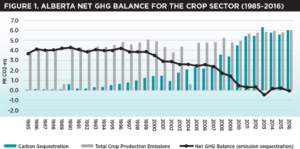Continue the Momentum on Carbon Sequestration
All human practices, including agriculture practices, are under review around the world as leaders look for science-based solutions to reduce emissions and sequester more carbon.
Meetings like the COP26, held from October 31 to November 12, 2021, in Glasgow, Scotland, set international expectations for climate goals. COP stands for “Conference of the Parties” and this year was the 26th annual meeting. For reference, the Paris Agreement came to fruition at COP21 and brought countries together on emissions reductions goals. The agricultural sector bears some responsibility for emissions reductions while also being responsible for providing food security to a growing population.
Here in Canada, the Agri-Food Innovation Council held a conference in October 2021 with the theme, “Agri-food research and innovation in service of a net-zero carbon economy”. One issue, covered by a few presenters, is the required balance between emissions reduction targets and global food supply. Ian Affleck, vice president of plant biotechnology at CropLife Canada, says the balance between food security and sustainability must be carefully monitored so that one is not being left behind in favour of the other. A key element to this will be innovation. Affleck pointed out that agriculture has the unique opportunity to feed the population as well as eat the carbon emissions from other industries. He encourages increased access to innovative science-based ideas and technologies for the wider agricultural sector.
While Canadian farmers can do better, they have already made great strides. The Saskatchewan Soil Conservation Association released a report called the Prairie Soil Carbon Project: Monitoring SOC Change Across Saskatchewan Farm from 1996 to 2018. This report states that samplings from 2011 and 2018 show that carbon sequestration continued through that time – it did not plateau.
Soil organic carbon (SOC) is “increasing on direct-seeded commercial farm fields in Saskatchewan,” the report says, and adds that further samplings “would be necessary to determine when carbon sequestration stops.” This is an example of solid science-based information that could increase the likelihood of the adoption of soil best management practices on farm.
Biological Carbon Canada released the Assessing Greenhouse Gas Sources and Sinks in the Crop Sector: Alberta & Manitoba document in January 2020. The objective of the study was to “quantify the greenhouse gas (GHG) sources and sinks in the Alberta and Manitoba sectors from 1985 to 2016”. The graph below is from the study and shows that the Alberta crop sector has reached net zero GHG emissions.
How to keep the momentum going
David Sauchyn, a climate scientist at the University of Regina, says a changing climate could bring opportunities such as crop diversification and a longer growing season, but also risks of extreme weather. Growers will want to adopt agricultural practices that will help them profit from a longer growing season and prepare as much as possible for more extreme weather. Sauchyn asserts that adaptation will have to occur in response to an amplification of extremes. It is likely that Alberta will see “wetter wet years and drier dry years”. Alberta is getting much less cold, and this will result in a shift in prairie ecosystems.
The Next Agricultural Policy Framework will replace the current Canadian Agricultural Partnership (CAP) in 2023 and become the next five-year investment by the governments to “strengthen and grow Canada’s agriculture and agri-food sector.” On June 3, 2021, Canada’s Minister of Agriculture and Agri-Food, Marie-Claude Bibeau, launched a federal consultation process for the framework. Federal, provincial and territorial governments met early in November 2021 to discuss changes. At the end of the conference, the Guelph Statement was issued and sets the tone for the framework.
Priorities in the Guelph Statement include:
- Supporting GHG emission reductions while positioning producers to seize economic opportunities
- Investing in science, research and innovation
- Supporting sustainable growth by meeting challenges of the domestic and global marketplace
- Building sector capacity and growth
- Enhancing resiliency, including business risk management programs

Concerns for food security are warranted. Changes in climate do affect the agricultural sector. Farmers are responsible for feeding everyone! Agriculture is one of the few industries that can sequester carbon to the point of creating offset credits for emitter industries. Support for the adoption of best practices and business risk management is needed if Canadians want continued access to affordable and healthy food choices.





